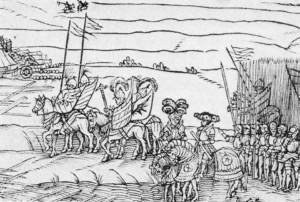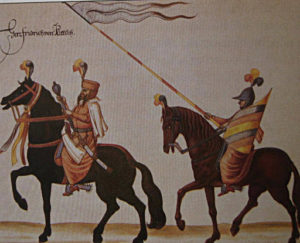The Long War, Part 12 / the second siege of Esztergom

The siege took place in 1595 and it was the second long and bloody siege around Esztergom in the last two years. The Christians seemed to have the upper hand but the Ottomans were heroically defending their castle. The Turks were running out of their supplies and everyone knew they would have to cede the castle unless they got reinforcement. Let us read the siege and the history of how the two reinforcing armies were defeated. Here you can read more about the first siege of Esztergom that took place in 1594:
The number of Imperial troops at Győr castle has been increasing. Most of them were Austrians, Czech, German, Italian, Walloon, and of course, Hungarian soldiers. The General was the seasoned and experienced Count Karl von Mansfeld.

There were in the army Nádasdy Ferenc and his cousin, Nádasdy Tamás II, the Comes of Vas County, along with Pálffy and Thurzó György and other aristocrats. (Note, I use the Eastern name order for Hungarian names.) We can see here for the first time mercenary leaders like Schwarzenberg, Johann von Tilly, and Giovanni Medici who became famous later. The army set out from Komárom Castle on 29 June and they pretended to attack Tata Castle to confuse the Ottoman forces. The Turk guards of Esztergom were totally surprised when they saw the Christian troops being deployed along the Danube River. Besides, the castle hadn`t been fully repaired after the previous siege yet and there were not enough defenders, they were only between 1,000-and 2,000 of them.

General Mansfeld has learned from the mistakes of last year and now he had the fort completely surrounded. The Walloon infantrymen were fighting hard to occupy the earth fortifications called Saint Tamás aka Tepedele, on 4 June. The next step was the artillery fire and when the cannons had done their work, several attacks were launched against the walls, yet unsuccessfully. General Mansfeld sent Pálffy and Nádasdy to the other bank of the Danube River to take up positions against the arrival of an eventual Ottoman reinforcement and at the same time, they were to take the Turks’ fort at Párkány (Sturovo) which was called Dzsigerdelen. This fort had been besieged between 16-24 July and finally, they could set it on fire and take it. The Turk defenders were either slaughtered or drowned in the Danube. Since then, the Christians have been able to bombard Esztergom from this side of the river, too.

Mansfeld established fortified places around Esztergom to defend it against a possible Ottoman reinforcement. And the reinforcement was indeed on the way. The chief commander of the Ottoman forces of Hungary was Serdar (General) Szinánpasazáde Mehmed and his army consisted of the troops of the local Sandjak centers, altogether about 15,000-16,000 men, including the Rumelian and the Anatolian forces. The Ottomans tried to divert the Christians` attention from the siege.

The Battle at Esztergom, 4 August 1595




Mansfeld told the defenders to surrender. Lala Mehmed had already taken over the command from Bey Kara Ali and he refused Mansfeld’s demand. Bey Ali died a few days later during an attack by the Christians. The Imperials were bombarding the castle from all sides. The time was urging them, too; and an epidemic broke out in the camp. Mansfeld got sick and he was taken to Komárom Castle where he died on 14 August. The new chief commander has become Archduke Matthias. Until he arrived, Pálffy and Count Karl von Burgau had been in charge and they succeeded in taking the Water Town through a several-hours-long bloody fight on 13 August. Thus, the defenders have lost an important fortification and their water supplies. In addition to this, the Christians received further reinforcement, sent by the Pope, led by General Aldobrandini. The defenders were fighting on, though, they repelled five assaults on 25 August but suffered heavy losses in the meanwhile.

The Battle of Pilisvörösvár 26-27 August 1595
Their last hope was the new Ottoman reinforcement which was being assembled in the valley of Pilisvörösvár. The Pasha of Buda called together the troops of the Sandjak districts of the Ottoman Occupied Lands of Hungary and thus, he could master 10,000 soldiers under his flag. However, the cavalry led by Nádasdy, Pálffy, Schwarzenberg, and Medici were sent against them to ambush the Ottoman camp on the night of 26-27 August. The Hungarian warriors set out on the evening of 26 August and they hurried through the dense forest of the Pilis hills and remained unnoticed. Under their flags, there were 8,000 men and 7 light cannons. The Turks were completely unaware in their night camp on the road between Esztergom, Óbuda, and Pilisvörösvár.
Nádasdy led the way with his 1,000 cavalrymen on the road through Szentlélek – Szentkereszt – Pilisszántó to get into the back of the enemy’s camp. He was expected to attack at the sight of an explosion, it was the sign. He was supposed to make the confusion of the enemy even bigger if he could. The main forces attempted to ambush the Turks from the direction of Piliscsaba.
Nádasdy came across a small Turk patrol unit and either cut them down or captured them. No one could take a message to the camp. Finally, he took up his position, and he soon noticed the agreed fire exploding on the Kopasz (Bold) hill. It was he who attacked first. Nádasdy was hindered a bit by the small stream and by the muddy, soft soil on the north of the Turks’ camp but his men “followed their valiant leader and rushed into the camp in one attack”. Here they joined Pálffy’s men and turned against the sleeping enemy.

It was so successful that they could cut down one part of the enemy while the rest were escaping. Allegedly, more than 200 Ottoman warriors perished there and 64 were captured. The Hungarians lost 83 men. However, the Ottoman warriors quickly regained consciousness and surrounded the Hungarians. They outnumbered them and the Hussars got into trouble. Seeing their plight, at first, Schwarzenberg did not want to go to their help but his Walloon soldiers ran to the aid of their fellow Hungarians.
When the other mercenaries saw the Walloons attack, joined in, and soon all the Christian forces were fighting off the confused enemy. It was the point when the Ottomans began panicking and fled. To his good luck, nobody chased them because it was still dark. The attackers could gain the Ottomans’ camp equipment as booty. When the Christians triumphally returned to the walls of Esztergom, they reported that no one had to be afraid anymore of the reinforcement of the Pasha of Buda.
As the defenders of Esztergom could not hope for further help coming and their fort was seriously damaged, and most of their soldiers had either perished or got wounded so the members of the Ottoman garrison forced Lala Mehmed to surrender on 1 September. After the negotiations, the defenders left the castle on the next day, bringing along their women and children.
The Chief Commander of the Christian forces became Pálffy and the taking of Esztergom made the position of Győr Castle very difficult.
They also took the fortified places of Zsámbék and Vörösvár which their Ottoman garrisons had abandoned. Due to the epidemics and the lack of discipline, Archduke Matthias didn’t dare to risk the siege of Buda castle and it was the end of this campaign.

Next, the Christian army took the small Castle of Visegrád, led by Pálffy, Aldobrandini, and Vincenzo Gonzaga, Archduke of Mantova between 16-21 September. However, the small Turk garrison, numbering only 300 defenders and led by Agha Oszmán, refused to surrender. The Christians began the bombardment of the walls and the Turks quickly changed their minds but then the Italians demanded they surrender and lay down their arms. While bargaining, they attacked the castle and the defenders gave up the fort for mercy. Everybody has been captured and the Christians placed there 200 Hungarian and 100 German guards.

Source: Szibler Gábor and Szerecz Miklós
Dear Readers, I can only make this content available through small donations or by selling my books or T-shirts.
If you like my writings, please feel free to support me with a coffee here:
You can check out my books on Amazon or Draft2Digital, they are available in hardcover, paperback, or ebook:
https://www.amazon.com/dp/198020490X
or at https://books2read.com/b/boYd81


My work can also be followed and supported on Patreon: Become a Patron!http://Become a Patron!



